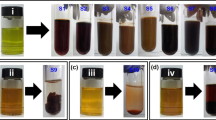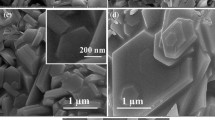Abstract
This paper describes the homogeneous precipitation of β-FeOOH nanorods (±5 nm dia.) in alcohol—water mixed solvents. Four alcohols, butanol (BuOH), propanol (PrOH), ethanol (EtOH) and methanol (MeOH), were mixed with water as the solvents to evaluate the effect of alcohols on the β-FeOOH particle characteristics under different hydrothermal process parameters. Crystal splitting was achieved at 0.7 M [FeCl3] in BuOH, and β-FeOOH nanoribbons were obtained in MeOH. Replacing Cl− with SO4 2− in a controlled pH (2) environment results a 98 % reduction in the synthesis time of hydronium iron jarosite, H3O.Fe3(SO4)2(OH)6, regardless of the nature of the alcohol. Single phase hydronium iron jarosite could not be synthesised without the presence of alcohol. Alcohol-to-water ratio played a critical role in controlling particle nucleation and growth. Spherical α-Fe2O3 (haematite) was obtained in pure alcohol, whereas an addition of 2 % (v/v) alcohol resulted in the precipitation of β-FeOOH nanofibrillar. Nanosize spherical α-Fe2O3 (average dia. 95 ± 19 nm) was achieved by altering solution pH in selective solvent. Required temperature for β-FeOOH to α-Fe2O3 transformation is solvent dependent and increases with the increasing carbon chain length in the linear alkyl chain of the solvent. The choice of solvent did not affect the Raman spectrum of the synthesised sample when compared to the standard Raman peaks. The synthesised β-FeOOH nanorods do not show ferromagnetism at any temperature down to 4 K and have a magnetic moment per unit mass of 1–1.5 Am2/kg at 5T.









Similar content being viewed by others
References
Amine K, Yasuda H, Yamachi M (1999) β-FeOOH, a new positive electrode material for lithium secondary batteries. J Power Sour 81–82:221–223
Bashir S, McCabe RW, Boxall C et al (2009) Synthesis of α- and β-FeOOH iron oxide nanoparticles in non-ionic surfactant medium. J Nanopart Res 11:701–706
Brayner R, Yepremian C, Djediat C et al (2009) Photosynthetic microorganism-mediated synthesis of akaganeite (β-FeOOH) nanorods. Langmuir 25:10062–10067
Chen HI, Chang HY (2004) Homogeneous precipitation of cerium dioxide nanoparticles in alcohol/water mixed solvents. Colloids Surf A 242:61–69
Chen M, Jiang J, Zhou X et al (2008) Preparation of akaganeite nanorods and their transformation to sphere shape hematite. J Nanosci Nanotechnol 8:3942–3948
Chen L, Yang X, Chen J et al (2010) Continuous shape and spectroscopy tuning of hematite nanocrystals. Inorg Chem 49:8411–8420
Chowdhury MR, Fester VG, Kale GM (2014) Growth kinetics evaluation of hydrothermally synthesised β-FeOOH nanorods. J Crys Gro 387:57–65
Cornell RM, Schwertmann U (2003) The iron oxides: structure, properties, reactions, occurrences and uses. Wiley, New York
Earle SA, Ramirez AP, Cava RJ (1999) The effect of gallium substitution for iron on the magnetic properties of hydronium iron jarosite. Phys B 262:199–204
Fester VG, Slatter PT, Biggs S et al (2008) Significance of alcohols in the synthesis of iron oxide nanorods. In: Azhar Uddin M (ed) Green chemistry & engineering, process intensification & nanotechnology conference. Albany, New York, pp 231–236
Guo X, Xiao P (2006) Effects of solvents on properties of nanocrystalline hydroxyapatite produced from hydrothermal process. J Eur Chem Soc 26:3383–3391
Khan Y, Durrani SK, Siddique M et al (2011) Hydrothermal synthesis of α-Fe2O3 nanoparticles capped by Tween-80. Mater Lett 65:2224–2227
Kumar A, Gupta SK (2013a) Synthesis of adenine mediated superparamagnetic colloidal β-FeOOH nanostructure(s): study of their morphological changes and magnetic behavior. J Nanopart Res 15:1466
Kumar A, Gupta SK (2013b) Synthesis of 5′-GMP-mediated porous hydrogel containing β-FeOOH nanostructures: optimization of its morphology, optical and magnetic properties. J Mater Chem B 1:5818–5830
Liang MT, Wang SH, Chang YL et al (2010) Iron oxide synthesis using a continuous hydrothermal and solvothermal system. Ceram Int 36:1131–1135
Liu L, Kou HZ, Mo W et al (2006) Surfactant-assisted synthesis of α-Fe2O3 nanotubes and nanorods with shape dependent magnetic properties. J Phys Chem B 110:15218–15223
Manna L, Milliron DJ, Meilsel A et al (2003) Controlled growth of tetrapod branched inorganic nanocrystal. Nat Mater 2:382–385
Millan A, Urtizberea A, Natividad E et al (2009) Akaganeite polymer nanocomposites. Polymer 50:1088–1094
Pu Z, Cao M, Yang J et al (2006) Controlled synthesis and growth mechanism of hematite nanorhombohedra, nanorods and nanocubes. Nanotechnol 17:799–804
Reguer S, Neff D, Gurlet B et al (2007) Deterioration of iron archaeological artefacts: micro-Raman investigation on Cl− containing corrosion products. J Raman Spectrosc 38:389
Shao HF, Qian XF, Yin et al (2005) Controlled morphology synthesis of β-FeOOH and the phase transition to Fe2O3. J Solid State Chem 178:3130–3136
Tang J, Alivisatos AP (2006) Crystal splitting in the growth of Bi2S3. Nano Lett 6:2701–2706
Wei C, Nan Z (2011) Effects of experimental conditions on One-dimensional single-crystal nanostructure of b-FeOOH. Mat Chem Phys 127:220–226
White AF (1990) Heterogeneous electrochemical reactions associated with oxidation of ferrous oxide and silicate surfaces. Rev Mineral Geochem 23:467–505
Xiong YJ, Xie Y, Chen SW et al (2003) Fabrication of self-supported patterns of aligned β-FeOOH nanowires by a low-temperature solution reaction. Chem Eur J 9:4991–4996
Yue J, Jiang X, Yu A (2011) Experimental and theoretical study on the β-FeOOH nanorods: growth and conversion. J Nanopart Res 13:3961–3974
Zhang LY, Xue DS, Fen J (2006) Magnetic properties of amorphous β-FeOOH nanowire arrays. J Magn Magn Mater 305:228–232
Acknowledgments
The authors acknowledge the National Research Foundation, South Africa and Cape Peninsula University of Technology for funding the study.
Author information
Authors and Affiliations
Corresponding author
Electronic supplementary material
Below is the link to the electronic supplementary material.
Rights and permissions
About this article
Cite this article
Chowdhury, M.R., Fester, V., Kale, G. et al. Hydrothermal precipitation of β-FeOOH nanostructure(s) in mixed solvent: study of their morphological and structural evolution. J Nanopart Res 16, 2412 (2014). https://doi.org/10.1007/s11051-014-2412-4
Received:
Accepted:
Published:
DOI: https://doi.org/10.1007/s11051-014-2412-4




